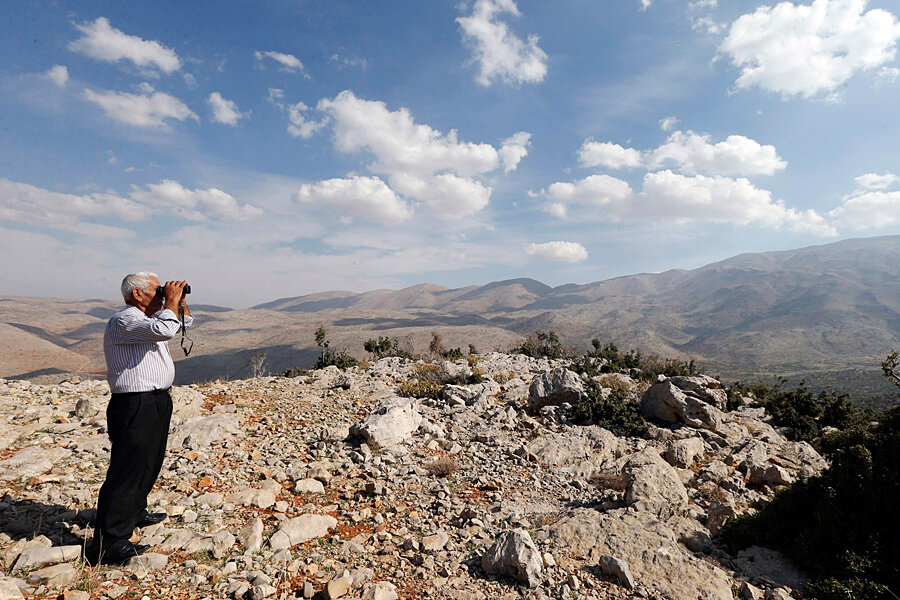British watchtowers dot a Mideast border again – this time with Islamic State
Loading...
| Tower 10, Northeast Lebanon
A lonely fortified watchtower built from stacked metal shipping containers, topped by a bullet-proofed observation booth, and protected from shrapnel and assaults by 18-foot-high walls of rock-filled Hesco barricades, marks the western edge of the regional campaign to check the expansion of the extremist Islamic State organization.
From here, on a small hill two miles east of the village of Ras Baalbek, the 100-plus Lebanese soldiers manning Tower 10 scan the lofty snow-capped mountains a few miles to the east that mark Lebanon’s border with Syria. In these mountains are around 3,000 mainly Syrian militants, including members of the Islamic State and Al Qaeda’s Syria franchise, Jabhat al-Nusra.
The recently-erected Tower 10 and others strung across this bleak mountain landscape are there to block the militants from attempting to break into populated areas of Lebanon lying to the west.
“A few kilometers inside Lebanon is like a thousand kilometers in Russia. There are only a few kilometers separating the border [with Syria] from the border villages,” says Brig.-Gen. Maroun Hitti, the Lebanese Army’s deputy chief of staff for planning.
That defensive line was tested late Tuesday when unidentified gunmen staged a deadly ambush against a Lebanese Army patrol close to Tower 10. At least six soldiers reportedly were killed and two others wounded. Loud explosions were heard in Ras Baalbek as artillery guns shelled the area.
The deadly ambush, the worst single loss of life for the Lebanese Army in months, underlines the critical value of the defensive perimeter being built along Lebanon's restive northeast border.
The fortified watchtowers are part of a British-funded project to enhance Lebanon’s border security. The project arose in late 2011 when the early peaceful demonstrations against the regime of Syrian President Bashar al-Assad were evolving into civil war. The descent of Syria and Iraq into chaos and violence has spurred the international community to lend some support to tiny Lebanon to prevent this vulnerable Mediterranean nation succumbing to the fate of its neighbors.
The United States dominates international assistance to the Lebanese Army, in the past year alone delivering more than $120 million in training, arms, and ammunition.
Britain's Mideast legacy
While the US leads the field today, Britain has a long and tangled history in the Middle East, once competing with rival European powers for territorial control of vast swathes of the region. A century ago, British military cartographers helped map some of the post-Ottoman borders of the modern Middle East, which today’s civil wars – and the extremists of the Islamic State – seem determined to erase.
Britain’s global military and political might long ago shriveled. But its past experience in border control in Northern Ireland and elsewhere allowed it to provide useful support to Lebanon.
“We could see three years ago that whatever was going to happening in Syria, there would be spillover into Lebanon. So it was very important that the border held at that stage…. The symbol of ISIL knocking over another border would be very powerful,” says Tom Fletcher, the British ambassador to Beirut, using an alternative acronym for the Islamic State.
The first watchtower went up along Lebanon’s northern border with Syria nearly two years ago. Since then 11 more have been erected, four of them along Lebanon’s volatile northeast frontier, which the Syrian militants use as a sanctuary from attack by the Syrian army.
Towers show their worth
In early August, some 700 militants charged out of the mountains and stormed Arsal, a Sunni border town. A Lebanese Army brigade newly arrived to garrison the town was ill-prepared for the sudden onslaught. Several soldiers were killed, including a battalion commander and his deputy, and poorly-protected positions were over-run.
The fortified watchtowers had yet to be built in Arsal at the time of the assault. But a few miles to the north, Tower 10, construction of which was completed only days before that attack, inadvertently deterred a potentially disastrous side assault by the Syrian militants against the nearby Christian population of Ras Baalbek. The militants chose to retreat when confronted by the fortified army position, apparently unaware it existed.
Still, although the Lebanese Army has reinforced its presence in the area, the attacks have not stopped. The militants probe Army defenses at night, firing vehicle-mounted heavy machine guns or launching roadside bomb ambushes. A 44-pound bomb was uncovered on Saturday on a track leading to Tower 12, which is under construction south of Arsal.
“We have every day some troubles. When they come to us, we shoot at them,” says Brig.-Gen. Ali Murad, commander of the Lebanese Army’s 2nd Land Border Regiment.
Eyes to the east
With the bitter winter months already here, Lebanese officials worry that the militants may try another break out from their lofty mountain redoubt, possibly attempting to reach Sunni areas close to the coast, a mere 30 miles to the west.
Helping guard Tower 10 to dominate the surrounding area are a US-made M60 tank, armored personnel carriers mounted with heavy machine guns, and 81mm mortars. Soldiers man firing positions along the outer wall while others sweep the mountains to the east with binoculars and powerful surveillance cameras.
“If any terrorists try to come here with a big number of people, we can repel them,” says Gen. Murad.





